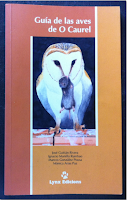 |
| Common Rock Thrush (Monticola saxatilis) |
Publishing firm Lynx Edicions published in 2004 the first ornithological guide to the Courel Mountains, one of the most biodiverse regions in Galicia.The book (available only in Spanish) is based on researches conducted over several decades by scientists of the Galician universities. These investigations resulted in the cataloging of 114 species of birds in a relatively small territory. The Courel Range covers an area of 21.020 hectares stretching mainly by the municipalities of Folgoso do Courel, Quiroga, Pedrafita do Cebreiro and Samos. However, the guide focuses primarily the first of these municipalities, with an area of only 68.16 square kilometers. This limited geographical space hosts an extremely varied avifauna comprising some uncommon species.
 |
| Sylvia communis |
 |
| Motacilla cinerea |
The birds of the Courel Mountains live in nine major habitat types: 1) Rivers and riverbanks 2) Rocky places 3) Villages and farmlands 4) Soutos (chestnut forests) 5) Devesas, local name for a characteristic type of mixed forests where grows many tree species 6) Heathlands 7) Reboleiras (forests of Quercus pyrenaica) 8) Holm oak woods and thorn bushes 9) Pinewoods
 |
| Eurasian Woodcock (Scolopax rusticola) |
The handbook
(150 pages) contains a descriptive listing of all bird species cataloged in this region (with common names in Spanish, Galician and English) and many watercolor illustrations. The guide also features six birding routes.
The original title of the book is Guía de las aves de O Caurel. The current official spelling of the toponym is Courel, but the alternative form Caurel (now more common in spoken language) is well documented since ancient times.


Nenhum comentário:
Postar um comentário